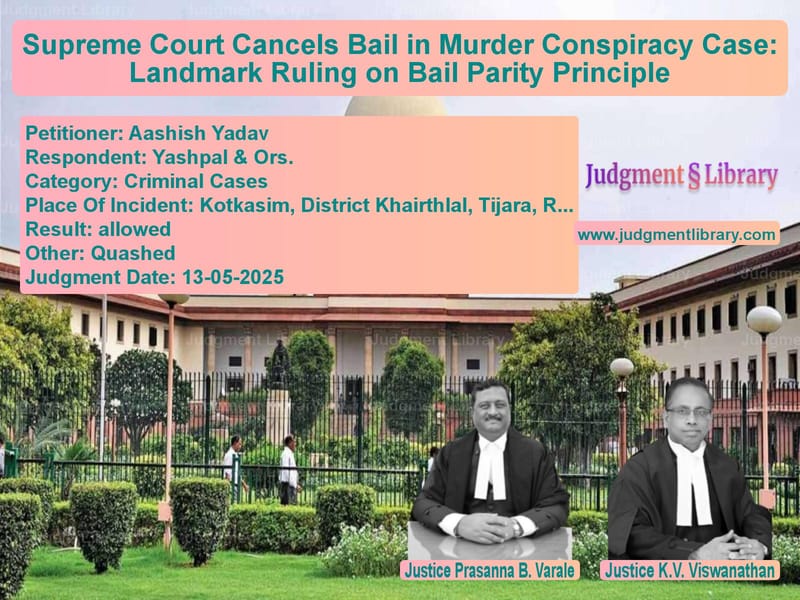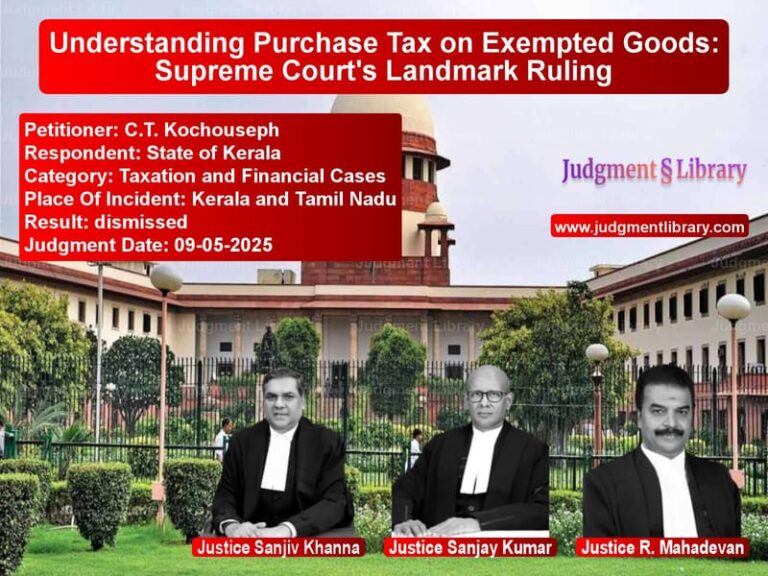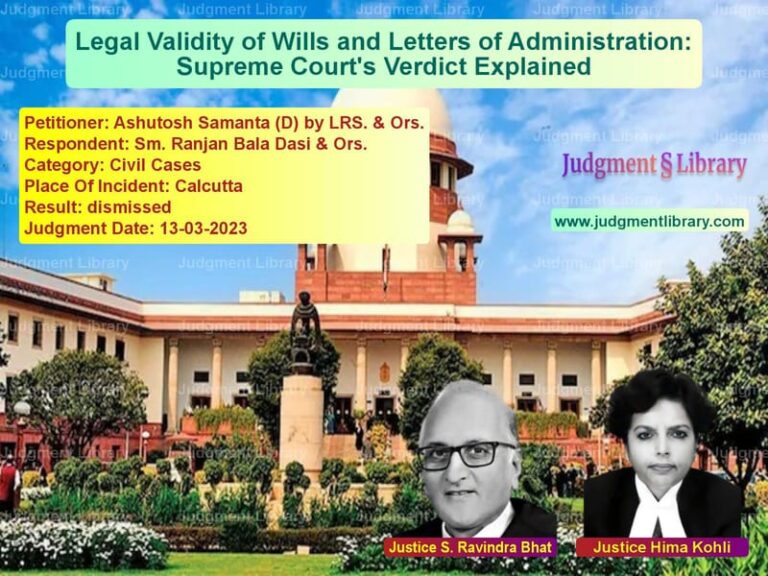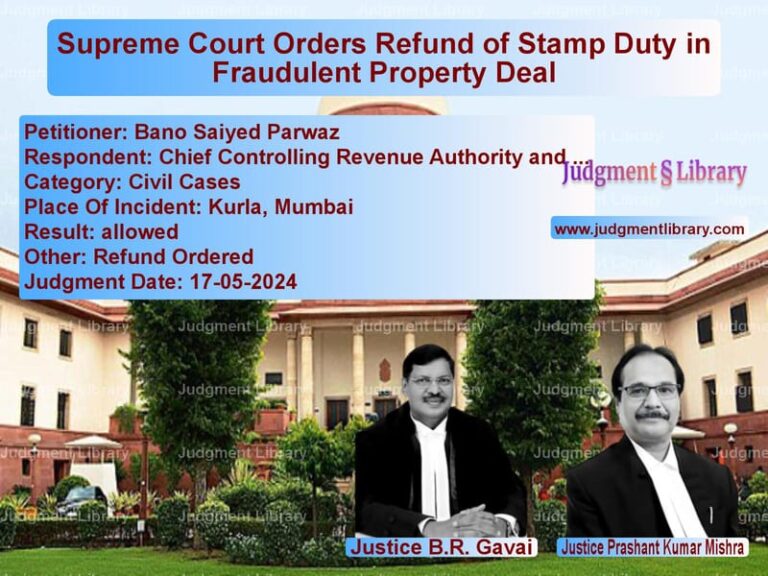Supreme Court Cancels Bail in Murder Conspiracy Case: Landmark Ruling on Bail Parity Principle
In a significant judgment that clarifies the limitations of bail parity in serious criminal cases, the Supreme Court has overturned the Rajasthan High Court’s decision granting bail to two accused persons in a brutal murder case involving a contract killer. The case, which stemmed from a violent incident during a marriage procession in Rajasthan, has brought into sharp focus the legal principles governing bail applications, particularly when dealing with serious offences like murder and criminal conspiracy.
The tragic events unfolded on November 28, 2023, during what should have been a joyous marriage procession in Kotkasim, Rajasthan. Instead of celebration, the occasion turned into a scene of horror when seven rounds of bullets were fired, resulting in the death of Aman Yadav and serious injuries to two others, Vikash and Naveen. The prosecution alleged that this was no spontaneous act of violence but a carefully planned execution orchestrated by the main accused, Yashpal and Raman, who had hired a contract killer known as Vicky @ Kartoos to eliminate Aman Yadav.
The legal battle reached the Supreme Court when Aashish Yadav, challenging the High Court’s decision to grant bail to Yashpal and Raman, argued that the principle of bail parity had been misapplied in a case involving such grave allegations. The Supreme Court’s subsequent ruling not only cancelled the bail but also provided crucial clarifications on when bail parity can and cannot be invoked.
The Prosecution’s Case: A Chilling Conspiracy
The prosecution presented a detailed narrative of events leading to the fatal shooting. According to the FIR registered at Kotkasim Police Station, the roots of the conflict dated back to November 19, 2023, when an argument occurred during a well worship ceremony in the village. This dispute escalated to the point where Yashpal and Raman allegedly decided to eliminate Aman Yadav, engaging the services of Vicky @ Kartoos, described in court documents as a “sharp shooter” and “contract killer” with multiple criminal cases against him.
The prosecution’s case was built on several crucial pieces of evidence. Three eyewitnesses, including the two injured persons, provided consistent accounts of the incident. The investigation revealed that Vicky @ Kartoos had even conducted a “test firing” before the actual shooting, indicating premeditation. Most significantly, the weapon used in the crime was recovered from the house of respondent No. 1 based on information provided by Vicky @ Kartoos in his statement under Section 27 of the Indian Evidence Act.
The chargesheet filed on February 27, 2024, clearly identified Yashpal and Raman as the “mastermind behind conspiracy to kill the victim.” Notably, the initial chargesheet had listed them as absconding accused, as they had successfully evaded arrest for six months following the incident, only surrendering before the Trial Court on May 14, 2024, after their bail applications were dismissed.
The Legal Battle: Arguments Before the Supreme Court
The appellant’s counsel presented compelling arguments against the grant of bail. They contended that “the High Court had earlier granted bail to the co-accused Kulwant, Sandeep and Omprakash on the ground that they were not the main accused who are the accused respondents herein. The counsel submitted that the High Court now cannot grant bail to the main accused respondents observing that the co-accused have been granted bail in the matter already.”
Emphasizing the gravity of the allegations, the appellant’s counsel argued that “the accused respondents are the mastermind behind the conspiracy to kill the victim and the same is established from the fact that on 19.11.2023 and 20.11.2023 there was serious fight between respondent accused and victim in which respondent accused gave life threats to the victim.”
The counsel also highlighted the dangerous profile of the contract killer, stating that “Vicky @ Kartoos is a contract killer/sharpshooter and has numerous cases against him and is a history sheeter wanted in various offences.” Most importantly, they raised legitimate concerns about the accused fleeing justice, submitting that “the accused respondents were absconding for six months and thus there is real apprehension that enlarging them on bail would lead the accused respondents to abscond again.”
In response, the counsel for the respondents attempted to downplay the seriousness of the allegations. They argued that “there has been a delay in filing the FIR and additionally the complainant is not an eyewitness to the incident either.” They further contended that “the statements of the eyewitnesses only indicate that it was a case of sudden fight and was not a planned conspiracy against anyone.” The defense also claimed that “there is no material on record to show and establish common intention of formation of unlawful assembly by the accused respondents.”
The Supreme Court’s Analysis: Rejecting Mechanical Application of Bail Parity
The Supreme Court, comprising Justices K.V. Viswanathan and Prasanna B. Varale, delivered a comprehensive analysis that went to the heart of bail jurisprudence in serious criminal cases. The Court expressed strong disagreement with the High Court’s approach, stating that “We do not find any merit in the submission made on behalf of the accused respondents whose bail application was allowed holding that no material against the accused person is available and there is nothing on record to show that the accused respondents actively participated in the act of firing the bullet.”
The Court emphasized that the absence of overt acts in the FIR could not be the sole consideration for granting bail in serious offences. In a significant observation, the Court noted that “merely because no overt act was attributed to the respondent accused in the First Information Report the same cannot be the sole consideration for grant of bail to these respondents in a serious offence under Section 302 of IPC. Time and again, it is observed by this Court that First Information Report is not an encyclopaedia of facts. An FIR is a starter point to set the investigation in motion and subsequently, the investigating agency collects the necessary material in the course of investigation so as to unearth the real offenders.”
The Court thoroughly examined the evidence collected during investigation and found it compelling. They observed that “in the present case also, in the course of investigation, the material collected by the investigating agency suggested that the respondent accused persons hatched a conspiracy so as to eliminate the victim and engaged a contract killer Vicky @ Kartoos to kill the victim Aman.”
The judges rejected the defense’s characterization of the incident as a spontaneous fight, stating that “We are unable to accept the submission of the learned counsel for the respondents that it was a sudden fight in the marriage procession that led to opening of firearm and shooting the victim. The material collected by the investigating agency in the form of statement of witnesses show that the respondent accused who have engaged a contract killer Vicky @ Kartoos were waiting for an opportune time so that they can use the hired contract killer to eliminate victim Aman.”
The Flawed Application of Bail Parity
The Supreme Court identified the fundamental error in the High Court’s reasoning regarding bail parity. The Court noted that “We find considerable merit in the submissions of learned counsel for the appellant that the High Court committed a serious error in holding and observing that the case of the respondents is at par with the case of other co-accused namely Sandeep and Omprakash.”
The Court highlighted the distinguishing factors that made the cases incomparable. Regarding Om Prakash’s bail, the Court pointed out that “it was observed in the order dated 19.03.2024 by the learned Judge, that specific allegations have been assigned to co-accused Yasphal, Raman and Vicky @ Kartoos. Another consideration was the age of Omprakash wherein the submission advanced before the learned Judge in respect of the age of Omprakash was accepted and it was observed that the petitioner i.e. Omprakash is an old infirm person of 84 years of age.”
This clear distinction between minor participants and the main conspirators formed the basis of the Supreme Court’s conclusion that bail parity was completely misplaced in this case.
The Sequence of Events: Unraveling the Conspiracy
The Supreme Court meticulously reconstructed the sequence of events based on the evidence collected during investigation. The Court described how “the marriage procession started and some of the young boys started dancing in the procession. Aman was also amongst them and while dancing the accused respondent got into an argument with victim Aman and his friends. Using this quarrel as an opportunity and as per the plan hatched by the respondents, the contract killer Vicky @ Kartoos by using the firearm i.e. pistol, shot victim Aman, resulting in his death and two other persons, Vikash and Naveen were also injured.”
The Court also noted the significant fact that “before the actual incident of shooting victim Aman, the contract killer Vicky @ Kartoos had opened the firearm for a test firing.” This detail, according to the Court, indicated careful planning and preparation rather than a spontaneous outburst of violence.
Flight Risk and Witness Intimidation Concerns
The Supreme Court gave considerable weight to the appellant’s concerns about the accused being a flight risk and potentially intimidating witnesses. The Court noted that “Admittedly, from the day of arrest till filing of the first chargesheet wherein these respondent accused were shown as absconding, the respondents were successful in evading their arrest and subsequently when the application for grant of bail was rejected these respondents accused surrendered themselves to the Trial Court.”
The Court also acknowledged the legitimate apprehension “that the respondent accused, if released on bail may pressurise the witnesses” given that “the contract killer Vicky @ Kartoos is having criminal antecedents and is a history sheeter.”
Most significantly, the Court agreed with the complainant’s submission that “as the trial is now in the process and key prosecution witnesses are yet to be examined, there exists a reasonable apprehension that if these accused persons are granted bail, then they may attempt to pressurise or influence the witnesses or even abscond.”
The Final Ruling and Its Implications
In its concluding remarks, the Supreme Court strongly criticized the High Court’s approach, stating that “The High Court therefore failed to consider these above grounds and has mechanically passed the order and allowed the appeal. The order of grant of bail to accused on parity is error apparent on the face of the record. The High Court failed to consider that the accused are the main accused in the matter and cannot be enlarged on bail because the other co-accused persons have been granted bail.”
The Court allowed the appeal and set aside the High Court’s bail order, directing that “the respondents are directed to surrender themselves to the concerned authority not later than two weeks from today.”
However, in a display of judicial restraint, the Court clarified that “Observations, in this judgment are only for the purpose of setting aside the bail order. The Trial Court is directed to decide the matter on its own merits, uninfluenced by the observations in this judgment.”
This landmark judgment serves as an important reminder that bail parity cannot be applied mechanically, especially in cases involving serious offences like murder and criminal conspiracy. The Supreme Court has reaffirmed that courts must conduct a thorough examination of the specific role of each accused, the nature of evidence against them, and the potential risks to the administration of justice before granting bail. The ruling emphasizes that while bail is the rule and jail the exception, this principle must be balanced against the need to ensure that justice is not thwarted by granting bail to individuals who may flee or interfere with the trial process.
Petitioner Name: Aashish Yadav.Respondent Name: Yashpal & Ors..Judgment By: Justice Prasanna B. Varale, Justice K.V. Viswanathan.Place Of Incident: Kotkasim, District Khairthlal, Tijara, Rajasthan.Judgment Date: 13-05-2025.Result: allowed.
Don’t miss out on the full details! Download the complete judgment in PDF format below and gain valuable insights instantly!
Download Judgment: aashish-yadav-vs-yashpal-&-ors.-supreme-court-of-india-judgment-dated-13-05-2025.pdf
Directly Download Judgment: Directly download this Judgment
See all petitions in Bail and Anticipatory Bail
See all petitions in Murder Cases
See all petitions in Criminal Conspiracy
See all petitions in Judgment by Prasanna Bhalachandra Varale
See all petitions in Judgment by K.V. Viswanathan
See all petitions in allowed
See all petitions in Quashed
See all petitions in supreme court of India judgments May 2025
See all petitions in 2025 judgments
See all posts in Criminal Cases Category
See all allowed petitions in Criminal Cases Category
See all Dismissed petitions in Criminal Cases Category
See all partially allowed petitions in Criminal Cases Category







